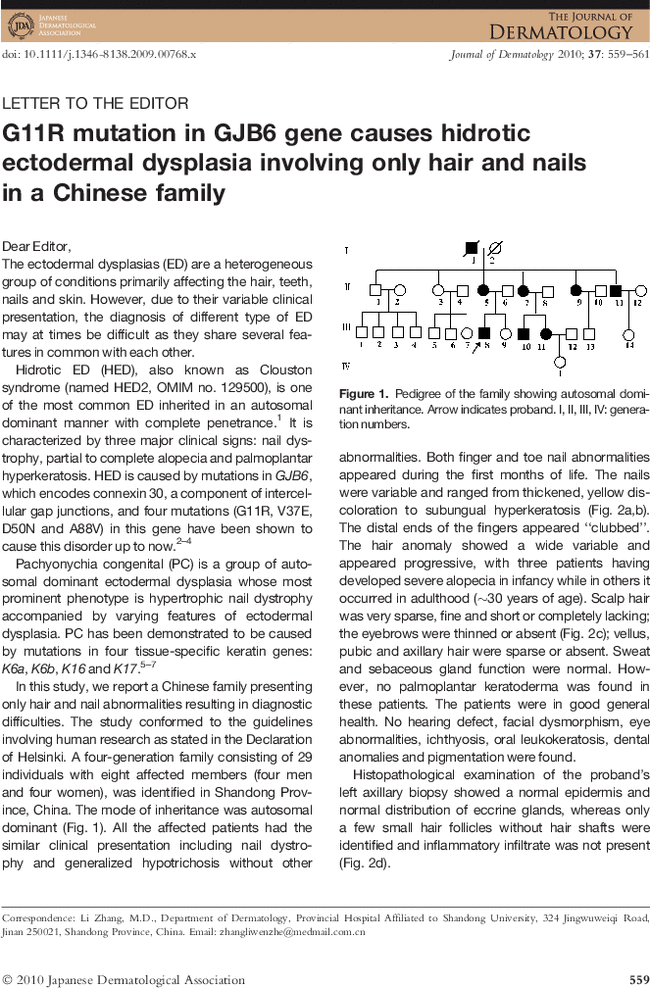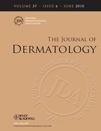G11R mutation in GJB6 gene causes hidrotic ectodermal dysplasia involving only hair and nails in a Chinese family
Nan CHEN
Department of Dermatology, Shandong Provincial Hospital Affiliated to Shandong University, Ji’nan
Nan Chen and Chao Xu contributed equally to this work.
Present address: Affiliated Hospital of Shandong University of Traditional Chinese Medicine, Jinan, China.
Search for more papers by this authorChao XU
State Key Laboratory of Medical Genomics, Center of Molecular Medicine, Ruijin Hospital, An Affiliate of Shanghai JiaoTong University Medical School, Shanghai
Nan Chen and Chao Xu contributed equally to this work.
Search for more papers by this authorBing HAN
State Key Laboratory of Medical Genomics, Center of Molecular Medicine, Ruijin Hospital, An Affiliate of Shanghai JiaoTong University Medical School, Shanghai
Search for more papers by this authorZhen-Ying WANG
Department of Dermatology, Shandong Provincial Hospital Affiliated to Shandong University, Ji’nan
Search for more papers by this authorYa-Li SONG
Department of Dermatology, Shandong Provincial Hospital Affiliated to Shandong University, Ji’nan
Search for more papers by this authorSong LI
Department of Dermatology, Shandong Provincial Hospital Affiliated to Shandong University, Ji’nan
Search for more papers by this authorRui-Li ZHANG
Department of Dermatology, Weihai Municipal Hospital, Weihai, China † These authors contributed equally to this work.
Search for more papers by this authorChun-Ming PAN
State Key Laboratory of Medical Genomics, Center of Molecular Medicine, Ruijin Hospital, An Affiliate of Shanghai JiaoTong University Medical School, Shanghai
Search for more papers by this authorLi ZHANG
Department of Dermatology, Shandong Provincial Hospital Affiliated to Shandong University, Ji’nan
Search for more papers by this authorNan CHEN
Department of Dermatology, Shandong Provincial Hospital Affiliated to Shandong University, Ji’nan
Nan Chen and Chao Xu contributed equally to this work.
Present address: Affiliated Hospital of Shandong University of Traditional Chinese Medicine, Jinan, China.
Search for more papers by this authorChao XU
State Key Laboratory of Medical Genomics, Center of Molecular Medicine, Ruijin Hospital, An Affiliate of Shanghai JiaoTong University Medical School, Shanghai
Nan Chen and Chao Xu contributed equally to this work.
Search for more papers by this authorBing HAN
State Key Laboratory of Medical Genomics, Center of Molecular Medicine, Ruijin Hospital, An Affiliate of Shanghai JiaoTong University Medical School, Shanghai
Search for more papers by this authorZhen-Ying WANG
Department of Dermatology, Shandong Provincial Hospital Affiliated to Shandong University, Ji’nan
Search for more papers by this authorYa-Li SONG
Department of Dermatology, Shandong Provincial Hospital Affiliated to Shandong University, Ji’nan
Search for more papers by this authorSong LI
Department of Dermatology, Shandong Provincial Hospital Affiliated to Shandong University, Ji’nan
Search for more papers by this authorRui-Li ZHANG
Department of Dermatology, Weihai Municipal Hospital, Weihai, China † These authors contributed equally to this work.
Search for more papers by this authorChun-Ming PAN
State Key Laboratory of Medical Genomics, Center of Molecular Medicine, Ruijin Hospital, An Affiliate of Shanghai JiaoTong University Medical School, Shanghai
Search for more papers by this authorLi ZHANG
Department of Dermatology, Shandong Provincial Hospital Affiliated to Shandong University, Ji’nan
Search for more papers by this authorPresent address: Affiliated Hospital of Shandong University of Traditional Chinese Medicine, Jinan, China.

References
- 1 Williams M, Fraser FC. Hydrotic ectodermal dysplasia – Clouston’s family revisited. Can Med Assoc J 1967; 96: 36–38.
- 2 Lamartine J, Munhoz Essenfelder G, Kibar Z et al. Mutations in GJB6 cause hidrotic ectodermal dysplasia. Nat Genet 2000; 26: 142–144.
- 3 Baris HN, Zlotogorski A, Peretz-Amit G et al. A novel GJB6 missense mutation in hidrotic ectodermal dysplasia 2 (Clouston syndrome) broadens its genotypic basis. Br J Dermatol 2008; 159: 1373–1376.
- 4 Smith FJ, Morley SM, McLean WH. A novel connexin 30 mutation in Clouston syndrome. J Invest Dermatol 2002; 118: 530–532.
- 5 McLean WH, Rugg EL, Lunny DP et al. Keratin 16 and keratin 17 mutations cause pachyonychia congenita. Nat Genet 1995; 9: 273–278.
- 6 Bowden PE, Haley JL, Kansky A et al. Mutation of a type II keratin gene (K6a) in pachyonychia congenita. Nat Genet 1995; 10: 363–365.
- 7 Smith FJ, Jonkman MF, Van Goor H et al. A mutation in human keratin K6b produces a phenocopy of the K17 disorder pachyonychia congenita type 2. Hum Mol Genet 1998; 7: 1143–1148.
- 8 Zhang XJ, Chen JJ, Yang S et al. A mutation in the connexin 30 gene in Chinese Han patients with hidrotic ectodermal dysplasia. J Dermatol Sci 2003; 32: 11–17.
- 9 Van Steensel MA, Jonkman MF, Van Geel M et al. Clouston syndrome can mimic pachyonychia congenita. J Invest Dermatol 2003; 121: 1035–1038.




